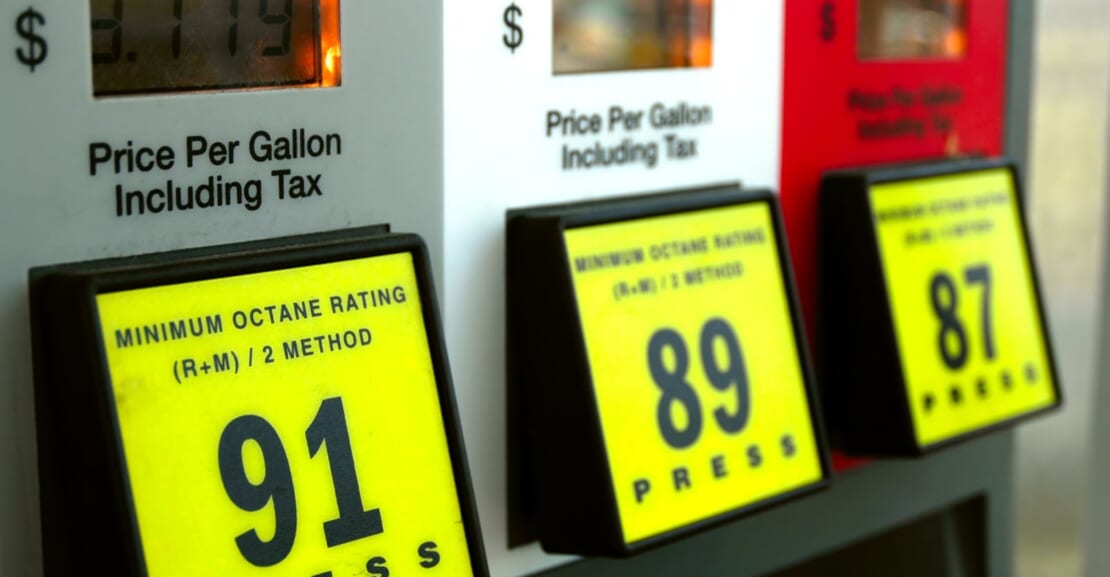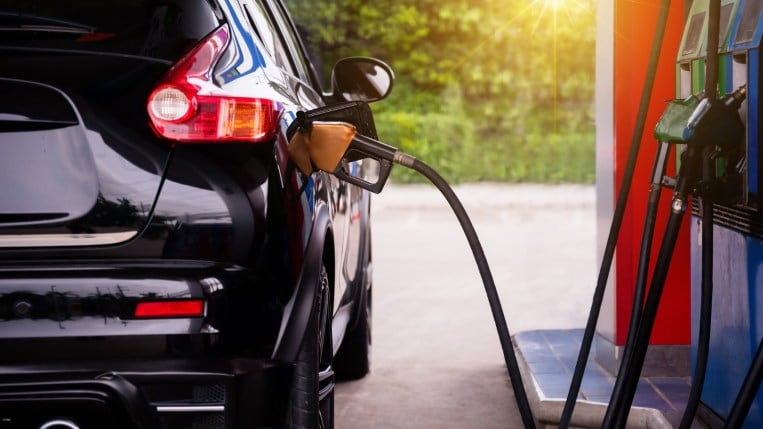Gas Types Quick Tips
Selecting a grade of gasoline simply because it has a higher octane rating might not be the best choice for your car or your budget. While some vehicles can benefit from premium gas, most drivers can save money at the pump by using regular unleaded in their vehicle without sacrificing performance.
This guide explains the different octane ratings for fuel found at gas stations, why some types of gasoline cost more, and which gas you should use for your car.
What Is Octane Rating?
The octane rating on different grades of gasoline is a measurement of the fuel’s stability. Higher octane numbers mean greater stability. The greater stability indicates the gasoline’s resistance to preignition and the fuel’s ability to resist “knocking” or “pinging” during combustion. These sounds come from the air-fuel mixture detonating prematurely in the engine.
Internal combustion engines compress a mixture of air and fuel and ignite them with a spark. Under certain conditions, the fuel-air mixture can ignite early, creating a knocking sound in the engine. Newer cars have sensors that prevent preignition, so you’ll rarely hear knocks and pings unless you drive an older vehicle.
A gasoline’s octane rating averages two testing methods — the research octane number (RON) under idle conditions and the motor octane number (MON) under higher engine speed. You might have noticed this formula in smaller letters on the yellow buttons displayed on gas pumps — (R+M)/2.
The larger numbers on gas pump stickers indicate the octane rating of the different gasoline grades. Typically, gas stations sell gasoline with three octane levels.
Regular
Regular unleaded gas is the lowest octane fuel at typically an 87 level and is suitable for most cars.
Mid-grade
Mid-grade is the middle-range fuel at usually an 89 octane level.
Premium
Premium is the highest-octane fuel you can buy and has levels of 91-94.
Even though some companies market their different grades of gas with names such as “Super Premium,” “Ultra,” or “Ultimate,” they all refer to the gasoline octane rating.
Which Gasoline or Fuel Should I Put in My Car?
The fundamental rule of car maintenance is to follow the manufacturer’s guidelines in the owner’s manual. It will show the minimum octane level for the vehicle and whether premium gas is recommended or required. There’s a distinct difference.
Recommended vs. Required Fuel Types
Cars that require premium fuel often have a warning notice at the gas cap and sometimes on the dashboard gas gauge reminding drivers to use the correct type of gas.
When your owner’s manual recommends a fuel type, you aren’t required to put it in your vehicle.
Generally, do what the manufacturer outlines in the owner’s manual, pay attention when filling up at the gas pump, and choose the right fuel for your car.
Higher octane fuel may be necessary for engines using a greater compression ratio or turbocharging to force more air into the cylinders. The use allows high-output engines to produce more power from the compressed air-fuel mixture. High-compression engines can require high-octane fuel to ensure the mixture doesn’t ignite early.
Using fuel with an octane level lower than what is recommended by the manufacturer can reduce engine performance. Over time, not following the octane guidelines for your car can cause damage to the engine and emissions control system.
It might also void the vehicle’s warranty.
Can You Use a Higher Octane Gas?
If your car is designed for regular-octane gas, you can safely use higher grades of gasoline. But under normal driving conditions, there is little to no benefit with buying fuel with octane levels greater than what is recommended. However, if you have an older car experiencing engine knock, filling up with premium gas for a few tanks might fix that problem.
There is no reason to panic if you unintentionally fill up your tank with a gasoline grade with an octane rating less than or greater than what the manufacturer recommends for the car.
However, a cause for concern is putting diesel fuel into the tank of a gas vehicle or pumping gasoline when the car requires diesel.
It’s difficult and uncommon, but not impossible, to put diesel fuel into a tank intended for gasoline. A diesel pump is a different color, usually green, and its nozzle is larger so it won’t fit into a gasoline tank’s opening. Accidentally putting diesel into your gasoline tank will require you to pay a dealership or local car repair shop to drain and clean the engine’s fuel line. Similarly, having gasoline in a diesel engine can cause damage to the fuel pump, filter, and injectors.
What Is Flex Fuel?
E85 is a fuel designed for “flex-fuel vehicles.” It is composed of 85% ethanol and 15% gasoline. E85 pumps are clearly labeled at gas stations and typically have yellow nozzles. Flex-fuel vehicles usually have a yellow fuel cap. Using gasoline of any octane level in a flex-fuel vehicle is OK. However, putting E85 in a car that isn’t designed for it can be harmful.
Most insurance policies don’t cover accidentally fueling up with the wrong gasoline type. However, some insurers offer riders that do cover the mishap. So check with your insurer and your policy. It is important to pay attention at the pump, avoid distraction, and know your car’s requirements.
What About E15?
Fuel labeled as E15 is gasoline blended with up to 15% ethanol. About 2,500 stations in 30 states sell the fuel. It typically costs about 10 cents less per gallon than regular unleaded gas.
E15 isn’t usually available in warmer months because of concerns around higher ethanol content contributing to smog in hot weather. However, the U.S. Environmental Protection Agency issued an emergency waiver in April 2022, allowing summertime sales to combat higher prices at the pump. When it issued the waiver, the EPA said that drivers can use E15 without worrying that it will impact air quality.
Understanding Diesel Fuel
Diesel fuel is the common term for petroleum distillate fuel. Gasoline and diesel engines operate differently and therefore use different types of fuel. Diesel is used in vehicles that use compression ignition engines, while gas engines are spark-ignited. In general, diesel engines work more efficiently and provide greater torque that is needed to move heavy loads, even though they generate less horsepower than their gasoline counterparts.
These days, the diesel car market in the United States is relatively small. However, many heavy-duty pickups and some vans are offered with optional turbo-diesel engines that bring the towing capacity that is desired for commercial work and off-road driving or for pulling boats and campers.
In addition to petroleum-based fuel, diesel engines are capable of using biodiesel that is produced from raw vegetable oil, used cooking oils, and waste animal fats.
Off-road Diesel
Off-road diesel is tax-exempt fuel designated for machinery and vehicles not operated on public roadways. Because it’s untaxed, this diesel costs about 25 cents less than what is commonly available at truck stops and many gas stations. However, the fuel contains a dye to help deter drivers from using it in street vehicles and makes it easier for investigators to identify unauthorized use.
Penalties for using tax-exempt motor fuel can be stiff. For example, Georgia law calls for a fine of not less than $1,000 and not more than $10,000 for using non-highway fuel for highway purposes. There are also federal penalties on the books. So, typical drivers should avoid buying dyed diesel unless it’s for farming purposes or home heating use.
RELATED: What is Payload: A Complete Guide
What Is Ethanol-Free Gas?
Non-ethanol gas is gasoline that isn’t blended with ethanol. This type of gas isn’t sold at every filling station. Using pure gas can lead to better mileage. But increased fuel economy from using ethanol-free gas may be offset by its higher cost. Non-ethanol gasoline typically costs more than ethanol-blended varieties.
Using non-ethanol gas in your car won’t harm the vehicle’s engine. You can mix ethanol-free gas with ethanol-blended varieties. However, using an ethanol blend may cause damage to your outdoor power equipment. Refer to your owner’s manual to learn if ethanol-free gas is the correct fuel to use for your tools.
What Is Recreational Fuel?
Some gas stations market ethanol-free 90-octane gasoline as “recreational fuel” or REC-90. Many consumers prefer to use non-ethanol fuel for marine equipment and small engines for lawnmowers, snowblowers, chainsaws, generators, pumps, and the like.
Why Do Some Gasoline Types Cost More Than Others?
The most noticeable difference between grades of gasoline is the cost, and motorists often wonder why higher-grade options cost more. The reason is that the additives and components used for boosting octane are generally more expensive to produce.
At the time of this writing, the average price of regular unleaded in the United States is $3.405 per gallon, and a gallon of mid-grade costs $3.828, according to AAA. The website shows that drivers buying high-octane premium gasoline can expect the price to be 75 cents more than regular, or $4.152 per gallon on average.
That means it costs $11.25 more to fill a 15-gallon tank with high-octane premium gas than it would with lower-octane regular.
Is Gas with Higher Octane Worth the Price Difference?
Absolutely. However, it’s only worth the price difference if your car requires higher-octane gasoline, such as mid-grade or premium fuel. Otherwise, you would be wasting money.
Some owner’s manuals indicate that fuel with a higher octane rating will make your car run better or more efficiently. Still, the increase in cost per gallon is typically higher than any reduction in gas consumption.
RELATED STORIES: Police Warn: Protect Yourself From Gas Theft
Price Factors for Gasoline
Many factors determine gasoline prices. Drivers often see higher prices in the summer driving season. Supply from refineries and demand from vacationing motorists can add up to 15 cents per gallon to gas prices in the summer months. Additionally, seasonal gasoline blends found at the pump contribute to price differences from one season to the next.
In warmer months, gasoline has a greater chance of evaporating from a car’s fuel system. To help offset smog and emissions, refiners produce a summer blend with lower volatility to reduce the chance of evaporation. Blends vary by state because of government regulations. These seasonal blends can add up to 15 cents per gallon on top of demand increases, depending on the region.
Cooler weather brings lower gas prices from September to April because the winter blend is cheaper to produce. The price at the pump can fall as much as 30 cents per gallon as gas stations switch to winter gasoline and many drivers stay closer to home.
Read Related Stories:
More KBB Guides:
Editor’s Note: This article has been updated since it was originally published.
Source link




